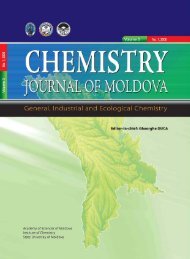stiinte med 1 2012.indd - Academia de ÅtiinÅ£e a Moldovei
stiinte med 1 2012.indd - Academia de ÅtiinÅ£e a Moldovei
stiinte med 1 2012.indd - Academia de ÅtiinÅ£e a Moldovei
You also want an ePaper? Increase the reach of your titles
YUMPU automatically turns print PDFs into web optimized ePapers that Google loves.
294<br />
(average 11 days), or up to restore normal urinary<br />
passage.<br />
Duration of surgery ranged between 50 and 120<br />
min. The average time used for this type of surgery<br />
was 67.39 ± 13.28 min.<br />
The total duration of hospitalization was 7 to<br />
37 days, the average hospital stay being 16.19 days.<br />
Postoperative hospitalization time was 5 to 32 days,<br />
the average of 12.32 days.<br />
To assess the effectiveness of surgical treatment<br />
was applied to evaluate the occurrence of diuresis in<br />
the kidney after surgery and functional values of preand<br />
postoperative kidney surgery (tab. 10, 11).<br />
Table 10<br />
The aparence of diuresis <strong>de</strong>pending of the method<br />
of surgery who was applied.<br />
1 – 3<br />
days p/o<br />
4 – 6<br />
days p/o<br />
7 – 10<br />
days p/o<br />
Bivalve nephrolithotomy - 7 11<br />
Anatrophic<br />
nephrolithotomy with - 1 4<br />
refrigerations<br />
Radial nephrolithotomy 12 11 -<br />
Pyelonephrolithotomy 18 10 -<br />
Calycolithotomy 4 - -<br />
The data presented in table 10 it is estimated<br />
that the more aggressive method has been applied<br />
aparence of the diuresis was longer and <strong>de</strong>pend of the<br />
tipe of operations.<br />
Table 11<br />
Functional values of pre-and postoperative kidney<br />
surgery (3 months)<br />
Before<br />
operations<br />
After<br />
operations<br />
F 1 F 2 F 3<br />
Total<br />
number after<br />
operations<br />
F 1 23 11 - 31<br />
F 2 3 17 5 25<br />
F 3 - 5 9 14<br />
F 4 - 1 3 4<br />
Before<br />
operations:<br />
total number<br />
26 30 17 73<br />
Because the treatment tactics was <strong>de</strong>scribed<br />
above, we have obtained success in the treatment of<br />
severe forms of nephrolithiasis. Acute pyelonephritis<br />
occurred in 18 (23.1%) patients, of which 2 (2.6%)<br />
patients with complicated severe infections of urinary<br />
tract with kidney removal.<br />
Postoperative bleeding:<br />
Early – were present in 5 (6.4%) patients, which<br />
4 (5.12%) was resolved conservatively, and in one<br />
Buletinul AŞM<br />
(1.28%) case was ma<strong>de</strong> reoperations with repeated<br />
suturing renal parenchyma .<br />
Late – were in 7 (8.97%) cases, of which 3<br />
(3.85%) patients required surgical treatment was repeated<br />
by nephrectomy because of profuse bleeding,<br />
the remaining four (5.13%) cases were resolved conservatively.<br />
Late postoperative nephrosclerosis was <strong>de</strong>tected<br />
in 4 (5.13%) patients.<br />
In most patients the stone mass was removed a<br />
single step, obtaining the rate “STONE FREE” of<br />
94.70%. Restant fragments, most of which up to 5<br />
mm in diameter were resolved with litholitic drugs<br />
and / or ESWL.<br />
Conclusions<br />
1. Radical surgical tehnics with minimal trauma<br />
and bleeding, for removing stones, are the basic direction<br />
in the treatment of CL.<br />
2. Despite the probability of any severe complications<br />
after nephrotomy the opening of renal parenchyma<br />
offers very good possibilities to visualize<br />
the kidney parenchyma and collecting system, which<br />
give a possibility to remove the stone in one step and<br />
increase the rate of “Stone Free”.<br />
3. Getting the correct indications and selection,<br />
based on data pre-and intraoperative makes the results<br />
of nephrolithotomy optimal for patients with severe<br />
and complicated forms of nephrolithiasis.<br />
Bibliography<br />
1. Joseph W., Segura J.W., Glenn M., Dean g. et al.,<br />
Nephrolithiasis Clinical Gui<strong>de</strong>lines Panel summary report<br />
on the management of staghorn calculi. The American<br />
Urological Association Nephrolithiasis Clinical Gui<strong>de</strong>lines<br />
Panel. J. Urol., 1994; 151(6): 1648-51.16.<br />
2. Дутов В.В., Современные способы лечения<br />
некоторых форм мочекаменной болезни. Дис. д-ра мед.<br />
наук. М., 2001.<br />
3. Sinescu I., Gluck G., Tratat <strong>de</strong> urologie. Vol II.,<br />
Geavlete P. Litiaza urinară. Bucureşti, 2008: 1025-1088.<br />
4. Тиктинский О.Л., Мочекаменная болезнь. О.Л.<br />
Тиктинский, В.П. Александров. – СПб, 2000, 384 с.<br />
5. Ceban E., Tratamentul diferenţiat al calculilor ureterali.<br />
Teza <strong>de</strong> doctor în ştiinţe <strong>med</strong>icale, Chişinău, 2003,<br />
p 3-4.<br />
6. Stamatelou K, K., Francis M.E., Jones C.A., Nyberg<br />
L.M., Curhan G.C., Time trends in reported prevalence of<br />
kidney stones in the United States: 1976-1994. Kidney Int.,<br />
2003; 63(5):1951-1952.<br />
7. Панин А.Г. , Патогенез дезинтеграции,<br />
растворения мочевых камней и физические методы<br />
лечения уролитиаза: Автореф. дисс. докт. мед. Наук,–<br />
СПб., 2000, 39 с.<br />
8. Blandy J.P., Singh M., The case for a more aggressive<br />
approach to staghorn stones. J. Urol., 1976; 1 IS:<br />
505.

















